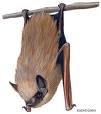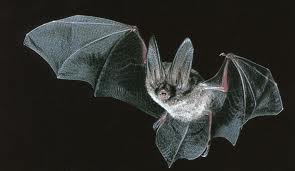| The Eastern Red Bat (Lasiurus Borealis) |

|
The Eastern Red Bat (Lasiurus Borealis)
This
is a medium-sized Vespertilionid, averaging weights of 9.5-14 g and measurements of 112.3 mm in total length. Adults are usually
dimorphic: males have red hair while females are chestnut-colored with whitish frosting on the tips of the fur. Like most
Vespertilionids, eastern red bats are insectivorous. Moths (Lepidoptera) form the majority of the diet, but red bats also prey heavily on beetles (Coleoptera), flies (Diptera), and other insects. Echolocation calls have low minimum frequencies, but calls are
highly variable ranging from (35-50 kHz). Eastern red bats are best suited for foraging in open spaces due to their body size,
wing shape, and echolocation call structure. However, red bats are frequently captured by researches foraging over narrow
streams and roads. Mating likely occurs in late summer or autumn and the sperm is stored in the female's reproductive tract
until spring when ovulation and fertilization occurs. In June, females usually give birth to three or four young and then
roost with their young until they are weaned. Males roost alone throughout the Summer. High temperature demands associated
with gestation and rearing young may limit the northern range for reproductive females. Eastern red bats often roost amongst
live or dead leaves on the branches of live hardwood trees, but have also been found using loblolly pine trees in pine plantations.
| Eastern Small Footed Myotis |

|
The Eastern Small-Footed Myotis (Myotis leibii)
The Eastern Small-footed Bat is a species of vesper bat in the Vespertilionidae family. It can be found in Ontario and Quebec in Canada and in the eastern United States. It is among the smallest bats in eastern North America. The Eastern Small-Footed Bat is 65–95 mm in total length, and weighs between 4–8 grams. It has a 25–45
mm (1–1.75") tail length, has a 210–250 mm (8.3-9.2") wingspan. Like all bats, the Eastern Small-Footed Bat has a flight membrane that connects the body to the forelimbs and tail, which creates the bats
flight. Its ears are under 15 mm (0.6"). Its fur is soft and silky, colored yellowish tan to golden brown . Its belly is gray,
while its face, ears, wings, and interfemoral membrane are black. Its distinguishing characteristics are its black face mask, and its tiny 7–8 mm (0.3") hind feet.The Eastern Small-Footed Bat ranges from The Northeastern United States and Canada down to Georgia and across to Oklahoma. They are active in mountainous regions from 240
to 1125 meters, preferring deciduous or coniferous forests. They may roost in rock bluffs, buildings, and turnpike tunnels during the spring and summer. They hibernate during
winters in caves and mines, hanging near the opening, or moving deeper as winter temperatures drop. Little is known about the reproductive habits of the Eastern Small-Footed Bat. Mating
usually occurs in Autumn, and the sperm is stored within the female until spring, when fertilization occurs. The offspring are born in late May to July.
| Northern Long Eared Myotis |

|
Northern Long-Eared Myotis
Northern long-eared bats (Myotis septentrionalis) are small bats, typically 5-10
g and 84 mm in total length [2]. The fur is dull
brown on the dorsum and yellowish on the venter. Compared to other Myotis species, these bats have long ears with a
relatively long tragus in each ear.
Females give birth to 1 pup each summer and often
form large maternity colonies (30-60 individuals) consisting mainly of females and their young. In the fall, northern long-eared
bats migrate to caves to hibernate. Migration distances are not known for this species. Northerns are often found roosting
singly in caves, rather than in the large clusters typical of other Myotis species, like Myotis sodalis.
Northern long-eared bats are
well-suited to foraging in the forest interior. Echolocation calls have a classic frequency-modulated (FM) structure that
allows these bats to navigate through cluttered environments. Further, their small size allows for more agility in dense vegetation.
Long ears allow northerns to find even stationary insects. Northerns' diets are focused on moths (Lepidoptera), which they
often capture by gleaning, or plucking, the insects from a surface. Gleaning is a unique foraging habit for insectivorous
bats since many capture their prey in flight. This species is found primarily in coniferous forest from Newfoundland to the Yukon, and in the southeastern
United States through to Florida. Specimens have
been found as far west as British Columbia and Texas
| Rafinesques Big Eared Bat |

|
Rafinesque's Big-eared Bat
The Rafinesque's Big-Eared Bat (Corynorhinus
rafinesquii) is a species of vesper bat in the Vespertilionidae family that occurs in the southeastern United States, and the states of Texas, Oklahoma, Illinois, Indiana and Ohio.. Corynorhinus rafinesquii is a medium-sized bat with long rabbit-like ears (27-37 mm). This bat
has large facial glands protruding from each side of its snout. Its fur is grayish brown above and conspicuously bicolored
underneath; each individual hair has a dark brown base and whitish tip. Its long toe hairs extend past the claws. It has a
forearm length of 39-43 mm and weighs 7-13 g. The similar Townsend's big-eared bat lacks contrasting bicolored ventral fur
and long toe hairs. Rafinesque's big-eared bat inhabits forests and streamside areas throughout the southeastern United States.
These agile flyers may be less frequently seen than some other bats because they leave their roosts only when it is completely
dark, forage for insects in the dark, and return to their roosts before sunrise. Curiously, they prefer roosting in locations
that have some amount of light. Their range overlaps that of several other forest-dwelling bats, such as the eastern pipistrelle,
the big brown bat, and some members of the genus Myotis. Rafinesque's Big-eared Bats are one of the least known bats in the southeastern United
States. Like all bats, big-eared bats help make our lives more comfortable by eating millions of bugs, especially mosquitoes,
every night. This bat uses its big ears and echolocation to help it find food. Because Rafinesque's Big-eared Bats feed on
insects that can be harmful to agriculture, people should treasure this animal. However, their numbers seem to be declining
and they have been listed as threatened since 1977. As people learn more about the role bats play in managing insect populations,
perhaps they will understand the importance of protecting bat roosts. Like all mammals, bats can contract rabies, but they
are no more susceptible to the disease than raccoons, skunks or even dogs. Just like other animals, bats will bite if they
feel threatened. If you find a bat on the ground (rabies immobilizes the animal sometimes), don't try to help it. Leave it
alone and call a game warden. The warden will be able to take care of the animal appropriately. Roost temperature requirements
for maternity colonies, as well as hibernating groups, are poorly understood. Most remaining colonies live in old buildings
that soon may be lost. More detailed nowledge of roost requirements is essential in order to provide artificial roosts. Feeding
habitat requirements also remain poorly documented.
 |

